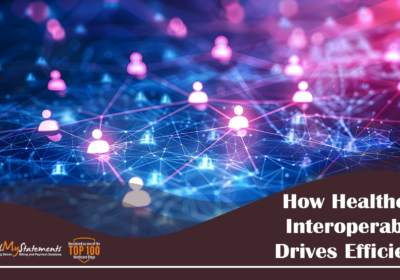8 Trends in Healthcare Billing for 2024

With a new year on the horizon, it’s a good time to look ahead at the upcoming trends in healthcare billing. As technology continues to evolve and regulations change, the patient billing landscape is also constantly shifting. In this environment, remaining adaptable is key—because now more than ever, those who resist change will run the risk of losing revenue and patients.
These are what we project to be the top trends in healthcare billing for 2024.
1. The Rise of Artificial Intelligence Continues
In recent years, artificial intelligence (AI) has become increasingly prevalent in the healthcare industry, whether in improving drug safety or diagnosing rare diseases. Billing is no exception.
From streamlining administrative tasks to improving customer service, AI and machine learning have proven to be valuable resources. In 2024, we can expect to see even greater integration of AI technology into healthcare billing processes.
AI-powered software can quickly analyze vast amounts of data and identify patterns that are likely to be missed by human billers. The result is a reduction in human error and increased accuracy of claims—and this means faster reimbursements for healthcare providers.
2. Increased Automation
Related to the rise of AI is an overall increase in automation. Autonomous coding and billing systems are becoming more advanced, allowing for faster and more accurate claim submissions.
In addition to automating coding and billing processes, there is a growing trend toward automating patient eligibility verification. This allows providers to quickly determine if a patient’s insurance will cover a specific service or treatment. By automating this process, healthcare professionals can reduce the risk of denied claims, improve overall revenue cycle management, and minimize patient frustration.
These changes have an impact on staff as well. Rather than threatening their jobs, which is often the fear with automated systems and AI, automation frees up employee time to engage in higher-level tasks and customer service. In addition, cloud-based systems allow employees to have flexible work arrangements, improving overall job satisfaction.
3. Growing Importance of Data Analytics
With the increasing use of electronic health records and other digital systems, healthcare organizations have access to vast amounts of patient data. In 2024, we can expect to see a greater emphasis on utilizing this data for billing purposes.
Data analytics can help identify areas for improvement, such as common billing errors or underutilized services, allowing healthcare providers to optimize their billing processes, which in turn can boost revenue. This data can also be helpful in tracking trends in payment patterns and insurance reimbursements, providing valuable insights to shape future policies and decisions. For example, as healthcare organizations evaluate and adopt outcomes-based payment models, data analytics is crucial to demonstrate the value of care.
4. Changing Regulations
As the healthcare industry continues to face scrutiny over rising costs and potential fraud, we may see an increase in regulatory oversight in 2024. This could include stricter auditing practices or more frequent updates to billing guidelines.
To stay compliant, healthcare organizations will need to strengthen compliance programs and ensure their billing processes are up-to-date with the latest regulations. Ensuring compliance may also require additional training for staff on new or updated procedures.
5. Patient-Centric Healthcare Billing
With increased cost-sharing between patients and insurance companies, consumers are becoming more involved in their healthcare billing. This, combined with a more generalized demand for user-friendly interfaces and processes across the board, means we can expect a continued shift to a more patient-centered approach to medical billing.
This means providing transparent and easy-to-understand bills, paperless billing (estatements), payment plans or other options for financial assistance, and technology that allows patients to easily manage their accounts online. Prioritizing the consumer experience allows healthcare providers to improve patient satisfaction and increase on-time payments.
6. Blockchain for Healthcare Billing
Blockchain technology is often associated with cryptocurrencies like Bitcoin, but it’s also making its way into the healthcare industry. We are likely to see more innovation in this area in 2024, and even the adoption of blockchain for medical billing and claims processing.
By using a decentralized ledger system, blockchain offers increased security and transparency in billing processes. Oracle predicts that blockchain can be used to protect against fraud and provide updated information for both healthcare providers and insurance companies by creating “a single source of truth to ensure interoperability and accessibility.”
7. Increased Emphasis on Cybersecurity
As more healthcare organizations transition to digital systems for billing, the risk of cyber attacks and data breaches becomes a growing concern. In the coming year, we can expect to see an increased emphasis on cybersecurity measures to protect patient information—and an increased demand from patients that their providers implement these measures.
Cyber resilience for healthcare billing systems includes implementing strict access controls like zero-knowledge authentication, conducting regular security audits, and investing in advanced security software. By prioritizing cybersecurity, healthcare providers can not only protect patient data, but also avoid costly fines and damage to their reputation.
8. Telemedicine Is Here to Stay
The COVID-19 pandemic may have accelerated the adoption of telemedicine, but that doesn’t mean the trend will reverse itself as the pandemic winds down. While there will always be a place for in-person doctor’s visits, patients appreciate the convenience of virtual care.
As telehealth becomes the norm, providers will need to ensure their billing processes are equipped to handle these types of services. This may involve updating coding and billing guidelines, as well as implementing technology that can accurately capture and bill for telemedicine services.
The Bottom Line
In the ever-evolving landscape of healthcare, proactive engagement with emerging trends in healthcare billing is not just advisable, but essential. As we move into 2024, embracing advancements like automation and data analytics will become increasingly critical for healthcare providers to maintain their competitive edge and guarantee continued delivery of quality care to their patients.
By partnering with MailMyStatements, you can provide your patients with a streamlined digital billing process and free up your staff’s time to offer more personalized customer service. Contact us today to learn more.
![]()



